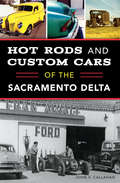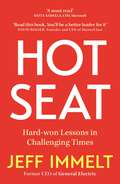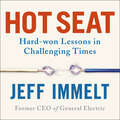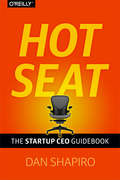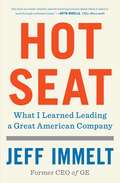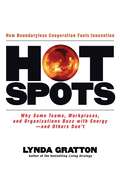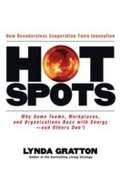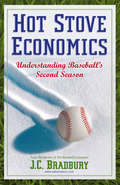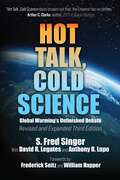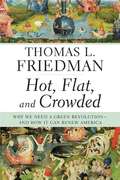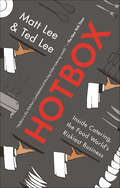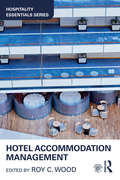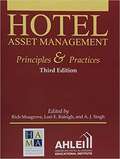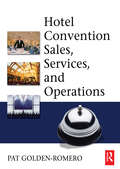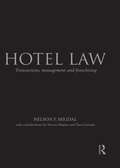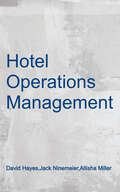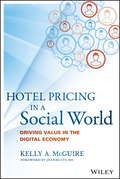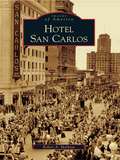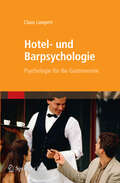- Table View
- List View
Hot Prospects
by Bill GoodWhatever good or service you're selling, five likely customers are worth a hundred random names. No one can help you find new business by finding those five -- or five hundred, or fifty thousand -- best-qualified customers better than Bill Good. For over a decade, Bill Good's guide to increasing new business by finding the right prospective customers has been an invaluable resource to people in every imaginable profession involving selling. Now completely revised and updated to include lessons on how email, fax machines, and the Internet can be incorporated into an effective prospecting and selling campaign, it is the most valuable tool a salesperson can own. Anyone who does any prospecting or selling by phone -- from securities, insurance, and real estate to fund-raising -- knows the frustrations and rejections inherent in "cold calling." Many people come to fear it. But why should this be so? Certainly there are people out there who need and want the product you're selling. If only you could more efficiently generate a list of just those people, weed out the hopeless cases, and launch a simple and highly effective campaign to win them to your side. Prospecting Your Way to Sales Success shows you how to do just that. Bill Good draws on all he's learned from a long, successful career teaching companies and individual entrepreneurs how to create successful prospecting campaigns. He jettisons the stale, old-school, don't-believe-a-customer-who-says-no philosophy for a plan of attack that finds good prospects while quickly screening out unqualified, uninterested customers. From the first contact to the final close, Bill Good will help you design a complete, customized prospecting campaign. In this new revised edition, bursting with fresh ideas for incorporating new media and new technologies into his proven campaign strategies, Bill Good has updated a classic and given salespeople everywhere a book they can't afford to live without.
Hot Rods and Custom Cars of the Sacramento Delta
by John V. CallahanThe Sacramento Delta has produced some of the finest hot rods and custom cars ever made. The passion of the area's builders is evident in the incredible cars they created, which drew nationwide attention. Harry Westerguard, who taught George Barris bodywork, worked on the second "America's Most Beautiful Roadster"----a 1923 "T" that was a style-setter for its day. Bob Dron built his first custom when he was only fifteen and a half, and Lenny Byer created his own "Candy Apple Red" in Rio Vista. Detroit might have had its vision, but the Delta region built its own. Discover the stories behind the cars and their builders as author John V. Callahan takes us on a trip down memory lane.
Hot Seat: Hard-won Lessons in Challenging Times
by Jeff ImmeltThe former CEO of General Electric, one of the most influential CEO's, shares the ideas and values of leadership he learned through times of crises. Jeff Immelt has always been one of my leadership role models. He leads with head and heart. This book shows how leadership is a full contact sport and Jeff leaves everything on the field. - John Donahoe, CEO, NikeRead this book. You'll be a better leader for it. - David Rogier, Founder and CEO, MasterClass__________In September 2001, Jeff Immelt replaced the most famous CEO in history, Jack Welch, at the helm of General Electric. Less than a week into his tenure, the 9/11 terrorist attacks shook the nation, and the company, to its core. GE was connected to nearly every part of the tragedy-GE-financed planes powered by GE-manufactured engines had just destroyed real estate that was insured by GE-issued policies. Facing an unprecedented situation, Immelt knew his response would set the tone for businesses everywhere that looked to GE-one of America's biggest and most-heralded corporations-for direction. No pressure.Over the next sixteen years, Immelt would lead GE through many more dire moments, from the 2008-09 Global Financial Crisis to the 2011 meltdown of Fukushima's nuclear reactors, which were designed by GE. But Immelt's biggest challenge was inherited: Welch had handed over a company that had great people, but was short on innovation. Immelt set out to change GE's focus by making it more global, more rooted in technology, and more diverse. But the stock market rarely rewarded his efforts, and GE struggled.In Hot Seat, Immelt offers a rigorous, candid interrogation of himself and his tenure, detailing for the first time his proudest moments and his biggest mistakes. The most crucial component of leadership, he writes, is the willingness to make decisions. But knowing what to do is a thousand times easier than knowing when to do it. Perseverance, combined with clear communication, can ensure progress, if not perfection, he says. That won't protect any CEO from second-guessing, but Immelt explains how he's pushed through even the most withering criticism: by staying focused on his team and the goals they tried to achieve. As the business world continues to be rocked by stunning economic upheaval, Hot Seat is an urgently needed, and unusually raw, source of authoritative guidance for decisive leadership in uncertain times.__________A memoir of successful leadership in times of crisis: the former CEO of General Electric, named one of the "World's Best CEOs" three times by Barron's, shares the hard-won lessons he learned from his experience leading GE immediately after 9/11, through the economic devastation of the 2008-09 financial crisis, and into an increasingly globalized world.
Hot Seat: Hard-won Lessons in Challenging Times
by Jeff ImmeltThe raw, page-turning, inspiring story of Jeff Immelt's 16 years leading the iconic General Electric. The former CEO of General Electric, one of the most influential CEO's, shares the ideas and values of leadership he learned through times of crises. Jeff Immelt has always been one of my leadership role models. He leads with head and heart. This book shows how leadership is a full contact sport and Jeff leaves everything on the field. - John Donahoe, CEO, NikeRead this book. You'll be a better leader for it. - David Rogier, Founder and CEO, MasterClass__________In September 2001, Jeff Immelt replaced the most famous CEO in history, Jack Welch, at the helm of General Electric. Less than a week into his tenure, the 9/11 terrorist attacks shook the nation, and the company, to its core. GE was connected to nearly every part of the tragedy-GE-financed planes powered by GE-manufactured engines had just destroyed real estate that was insured by GE-issued policies. Facing an unprecedented situation, Immelt knew his response would set the tone for businesses everywhere that looked to GE-one of America's biggest and most-heralded corporations-for direction. No pressure.Over the next sixteen years, Immelt would lead GE through many more dire moments, from the 2008-09 Global Financial Crisis to the 2011 meltdown of Fukushima's nuclear reactors, which were designed by GE. But Immelt's biggest challenge was inherited: Welch had handed over a company that had great people, but was short on innovation. Immelt set out to change GE's focus by making it more global, more rooted in technology, and more diverse. But the stock market rarely rewarded his efforts, and GE struggled.In Hot Seat, Immelt offers a rigorous, candid interrogation of himself and his tenure, detailing for the first time his proudest moments and his biggest mistakes. The most crucial component of leadership, he writes, is the willingness to make decisions. But knowing what to do is a thousand times easier than knowing when to do it. Perseverance, combined with clear communication, can ensure progress, if not perfection, he says. That won't protect any CEO from second-guessing, but Immelt explains how he's pushed through even the most withering criticism: by staying focused on his team and the goals they tried to achieve. As the business world continues to be rocked by stunning economic upheaval, Hot Seat is an urgently needed, and unusually raw, source of authoritative guidance for decisive leadership in uncertain times.__________A memoir of successful leadership in times of crisis: the former CEO of General Electric, named one of the "World's Best CEOs" three times by Barron's, shares the hard-won lessons he learned from his experience leading GE immediately after 9/11, through the economic devastation of the 2008-09 financial crisis, and into an increasingly globalized world.(P) 2021 Simon & Schuster Inc
Hot Seat: The Startup CEO Guidebook
by Dan ShapiroWhat avoidable problem destroys more young startups than any other?Why is it a mistake to ask for introductions to investors?When do you play the CEO card?Should you sell out?Author and four-time founder/CEO Dan Shapiro tells the stories of dozens of startups whose companies lived and died by the advice in these pages. From inception to destruction and triumph to despair, this rollercoaster read takes aspiring entrepreneurs from the highs of billion-dollar payouts and market-smashing success to the depths of impostor syndrome and bankruptcy.Hot Seat is divided into the five phases of the startup CEO experience:Founding explains how to formulate your idea, allocate equity, and not argue yourself to deathFunding provides the keys to venture capital, angels, and crowdfunding, plus clear advice on which approach to chooseLeadership lays out a path to build a strategy and culture for your team that will survive good times and badManagement reveals how to manage your board, argue with your team, and play the CEO cardEndgame explains how to finish a company's existence with grace, wealth, and minimal litigation
Hot Seat: What I Learned Leading a Great American Company
by Jeff ImmeltA memoir of successful leadership in times of crisis: the former CEO of General Electric, named one of the &“World&’s Best CEOs&” three times by Barron&’s, shares the hard-won lessons he learned from his experience leading GE immediately after 9/11, through the economic devastation of the 2008–09 financial crisis, and into an increasingly globalized world.In September 2001, Jeff Immelt replaced the most famous CEO in history, Jack Welch, at the helm of General Electric. Less than a week into his tenure, the 9/11 terrorist attacks shook the nation, and the company, to its core. GE was connected to nearly every part of the tragedy—GE-financed planes powered by GE-manufactured engines had just destroyed real estate that was insured by GE-issued policies. Facing an unprecedented situation, Immelt knew his response would set the tone for businesses everywhere that looked to GE—one of America&’s biggest and most-heralded corporations—for direction. No pressure. Over the next sixteen years, Immelt would lead GE through many more dire moments, from the 2008–09 Global Financial Crisis to the 2011 meltdown of Fukushima&’s nuclear reactors, which were designed by GE. But Immelt&’s biggest challenge was inherited: Welch had handed over a company that had great people, but was short on innovation. Immelt set out to change GE&’s focus by making it more global, more rooted in technology, and more diverse. But the stock market rarely rewarded his efforts, and GE struggled. In Hot Seat, Immelt offers a rigorous, candid interrogation of himself and his tenure, detailing for the first time his proudest moments and his biggest mistakes. The most crucial component of leadership, he writes, is the willingness to make decisions. But knowing what to do is a thousand times easier than knowing when to do it. Perseverance, combined with clear communication, can ensure progress, if not perfection, he says. That won&’t protect any CEO from second-guessing, but Immelt explains how he&’s pushed through even the most withering criticism: by staying focused on his team and the goals they tried to achieve. As the business world continues to be rocked by stunning economic upheaval, Hot Seat is an urgently needed, and unusually raw, source of authoritative guidance for decisive leadership in uncertain times.
Hot Spots: Why Some Teams, Workplaces, and Organizations Buzz with Energy - And Others Don't
by Lynda GrattonYou always know when you are in a Hot Spot. You feel energized and vibrantly alive. Your brain is buzzing with ideas, and the people around you share your joy and excitement. Things you've always known become clearer, adding value becomes more possible. Ideas and insights from others miraculously combine with your own to create new thinking and innovation. When Hot Spots arise in and between companies, they provide energy for exploiting and applying knowledge that is already known and genuinely exploring what was previously unknown. Hot Spots are marvelous creators of value for organizations and wonderful, life-enhancing phenomena for each of us. Lynda Gratton has spent more than ten years investigating Hot Spots--discovering how they emerge and how organizations can create environments where they will proliferate and thrive. She has studied dozens of companies and talked to hundreds of employees, managers, and executives in the US, Europe, and Asia. She has asked the important questions: Why and when do Hot Spots emerge? What is it about certain groups of people that support the emergence of Hot Spots? What role do leaders play? She's discovered a host of elements that together contribute to the emergence of Hot Spots--creating energy and excitement, and supporting and channeling that energy into productive outcomes. In this groundbreaking book, Gratton describes four crucial qualities that an organizational culture must have to support the emergence of Hot Spots, looks at what leaders can do to encourage them, and offers activities and tools you can use in your own company to increase the probability of them arising. In these days when traditional organizational boundaries are becoming barriers to progress, Gratton offers advice and guidance that you can use right now to increase the probability of Hot Spots emerging in your organization.
Hot Spots: Why Some Teams, Workplaces, and Organizations Buzz with Energy--and Others Don't
by Lynda GrattonWhat organization wouldn't want to encourage "places and times where cooperation flourishes, thus creating great energy, innovation, productivity and excitement"? This final volume in a trilogy of books on creating energy at work by London Business School professor Gratton (after Living Strategy and The Democratic Enterprise) attempts to analyze the ingredients of positive workplace energy. Gratton details ways to foster a cooperative mindset, remove boundaries between people, give them a sense of purpose and increase their productive capacity, drawing on examples from organizations like BP and Nokia. But despite her interesting and well-organized findings, some readers may find her intensive focus on scientific research too academic, particularly the complicated diagrams and formulae for workplace qualities that are difficult to quantify.-Publishers Weekly
Hot Stove Economics
by J. C. BradburyThe final out of the World Series marks the beginning of baseball's second season, when teams court free agents and orchestrate trades with the hope of building a championship contender. The real and anticipated transactions generate excitement among fans who discuss the merit of moves in the arena informally known as the "hot stove league." In Hot Stove Economics, economist J.C. Bradbury answers the hot stove league's most important question: what are baseball players worth? With in-depth analysis, Bradbury identifies the game's best and worst contracts--revealing the bargains, duds, and players who are worth every penny they receive. From minor-league prospects to major-league MVPs, Bradbury examines how factors such as revenue growth, labor rules, and aging-- even down to the month in which players are born--shape players' worth and evaluates how well franchises manage their rosters. He broadly applies the principles of economics to baseball in a way that is both interesting and understandable to sports fanatics, team managers, armchair economists and students alike.
Hot Talk, Cold Science: Global Warming's Unfinished Debate
by S. Fred Singer David R. Legates Anthony R. LupoThe revised and expanded third edition of Hot Talk, Cold Science forms the capstone of the distinguished astrophysicist Dr. S. Fred Singer&’s lucid, yet hard scientific look at climate change. And the book is no less explosive than its predecessors—and certainly never more timely.Singer explores the inaccuracies in historical climate data and the failures of climate models, as well as the impact of solar variability, clouds, ocean currents, and sea levels on global climate—plus factors that could mitigate any human impact on world climate. Singer&’s masterful analysis decisively shows that the pessimistic, and often alarming, global-warming scenarios depicted in the media have no scientific basis. In fact, he finds that many aspects of increased levels of CO2, as well as any modest warming, such as a longer growing seasons for food and a reduced need to use fossil fuels for heating, would have a highly positive impact on the human race. As alarmists clamor to impose draconian government restrictions on entire populations in order to combat "climate change," this book reveals some other startling, stubborn contradictory facts, including: CO2 has not caused temperatures or sea levels to rise beyond historical rates. Severe storms have not increased in frequency or intensity since 1970—neither have heat waves nor droughts. Global "climate change" is not harming coral reefs. Any increases in CO2 concentrations across huge time spans haven't preceded rising global temperatures, they&’ve followed them by about 600 to 800 years—just the opposite of alarmist claims. "Carbon" taxes and other "solutions" to the global warming "crisis" would have severe consequences for economically disadvantaged groups and nations. Alarmist climate scientists have hidden their raw temperature data and deleted emails—then undermined the peer-review system to squelch debate. In sum, despite all the hot talk—and outright duplicity—there is no "climate crisis" resulting from human activities and no such threat on the horizon.
Hot Wheels at Mattel: Reinventing the Wheel
by Elie Ofek Nicole Tempest Keller Andres TerechIn 2017, Chris Down, Global Brand General Manager for Hot Wheels, and his team from the Advanced Play Group within Mattel, Inc., were considering which innovation path to pursue in order to "future proof" the Hot Wheels franchise going forward. Hot Wheels was the number one selling toy in the world (by unit volume), however, play patterns among children were rapidly changing and children were moving on from physical toys to digital play at a younger and younger age. Hot Wheels needed to determine how to respond. One option considered was the development of a new "mixed-play" product that blended physical and digital play. While the mixed play idea was still at an early conceptual stage, it would likely involve embedding a chip into the Hot Wheels die-cast car, turning it into a "smart car" with its own unique identification. Users could play with the smart car in the physical world and on an app, thus offering an opportunity to also appeal to Hot Wheels consumers who were intrigued by digital play. Hot Wheels had made a number of forays into the digital space over the years, through licensing the brand to app and game developers and developing toys with some digital elements. The licensing strategy was low risk, low reward, and Mattel's own digital development had produced varied results, creating a culture hesitant to take big risks in the digital space. Down knew that a mixed play innovation would require a significant investment in time and resources. However, Hot Wheels parent company, Mattel Inc. had seen revenues and operating income drop for the past three years. It was unclear if Mattel's new CEO, Margo Georgiadis, would be supportive of the mixed play direction as the cornerstone of Hot Wheels' growth plan.
Hot Wheels: Launching The Mixed Play Experience
by Elie Ofek Nicole Tempest Keller Andres TerechChris Down, Global Brand General Manager for Hot Wheels, and his team from the Advanced Play Group within Mattel, Inc., had developed an entirely new "mixed play" product experience that blended familiar Hot Wheels play in the physical world with breakthrough play in the digital world. The technology underlying the product was an NFC chip embedded in the physical Hot Wheels die-cast car that could be scanned to add a digital version of the car into a virtual domain, where users could see their stats and play video games with the car. The goal for the new mixed play experience was to extend the age of the Hot Wheels customer, as children were observed to be moving on from physical toys to digital play at a younger and younger age. The mixed play concept had received unprecedented investment and support, since it represented a whole new approach to play that could set the stage for the future of Hot Wheels and other Mattel brands. In early 2019, the product development phase was nearly complete and plans were being set for the launch. Key decisions needed to be made around positioning, naming, pricing, channel, promotion, and launch timing. Given the high expectations for the innovative mixed play platform, it was critical to get these go-to-market decisions right.
Hot, Flat, and Crowded: Why We Need a Green Revolution - and How It Can Renew America
by Thomas L. FriedmanFriedman shows how the 2 biggest crises of today (America's loss of focus since 9/11 and the global environment crisis) are linked and how we can restore the world and revive America at the same time
Hotbox: Inside Catering, the Food World's Riskiest Business
by Matt Lee Ted LeeJames Beard Award–winning journalists expose food industry secrets in “the Kitchen Confidential of the big-ticket catering world” (New York Times).Hotbox reveals the real-life drama behind cavernous event spaces and soaring white tents, where cooking conditions have more in common with a mobile army hospital than a restaurant. Award-winning food writers the Lee brothers steeped themselves in the catering business for four years, learning the culture from the inside out. It’s a realm where you find eccentric characters, working in extreme conditions, who must produce magical events and instantly adapt when, for instance, the host’s toast runs a half-hour too long, a hail storm erupts, or a rolling rack of hundreds of ice cream desserts goes wheels-up.Whether they’re dashing through black-tie fundraisers or celebrity-spotting at a Hamptons cookout, the Lee brothers guide you on a romp from the inner circle—the elite team of chefs using little more than their wits and Sterno to turn out lamb shanks for eight hundred—to the outer reaches of the industries that facilitate the most dazzling galas. You’ll never attend a party—or entertain on your own—in the same way after reading this book.“Lively . . . [with] just the right combination of sophistication and self-deprecation [to] show us what really goes on behind the scenes.” —The Wall Street Journal“An absorbing, immersive, appetizing tale, written with sharp intelligence and style.” —Susan Orlean, New York Times–bestselling author of The Library Book“Brilliant, gleeful . . . full of tips and secrets.” —Bill Buford, national bestselling author of Heat“[A] captivating tell-all.” —Publishers Weekly
Hotel Accommodation Management (Hospitality Essentials Series)
by Roy C. Wood<p>This book offers students a uniquely concise, accessible and comprehensive introduction to hotel accommodation management that covers the range of managerial subjects and disciplines in the sector. <p>The book focuses on enduring aspects of the accommodation management function (front office management, housekeeping, revenue management); the changing context of hotel accommodation provision (the move to ‘asset light’, the supply of accommodation, trends in hotel investment and asset management, the challenges engendered by social media and the collaborative economy to the hotel market); and the role of accommodation in additional and integrated facilities and markets (spas, resorts, MICE markets). <p>International case studies illustrating examples of practice in the industry are integrated throughout, along with study questions and other features to aid understanding and problem solving. This is essential reading for all hospitality and hotel management students.</p>
Hotel And Lodging Management: An Introduction
by Alan T. Stutts James F. WortmanHotel and Lodging Management, Second Edition prepares readers to succeed as managers in the hotel and lodging industry, while developing a solid foundation for a long and successful career. This comprehensive resource combines detailed presentations of each department in a hotel or lodging establishment along with a close examination of organizational structure and the interdependent relationship among departments. This updated Second Edition presents: New, completely updated chapters on human resources and the sales and marketing departments Up-to-date case studies reflecting the latest management trends and issues Profiles of industry pioneers working at all types of properties, from small motels to five-star hotels New sections on yield management, lodging environments, franchise companies, and management organizations Hotel and Lodging Management, Second Edition is a comprehensive tool to help readers develop the understanding, knowledge, and skills to be tomorrow's management leaders.
Hotel Asset Management: Principles And Practices
by Rich Musgrove Lori Raleigh A. J. SinghThe third edition of this book takes a look at the challenges and opportunities faced by hotel owners, lodging industry real estate professionals, and hotel company executives, with articles written by industry leaders in asset management. This edition is the most comprehensive to date and includes twenty-one chapters by 36 authors, covering topics of keen interest to hotel owners, investors and asset managers.
Hotel Convention Sales, Services and Operations
by Pat Golden-RomeroThis text provides a comprehensive look at the fast growing meetings and convention market segment. A useful “how- to” guide, it takes students through all aspects of selling and servicing a convention at a hotel or other group meeting facility. In addition, it profiles the customer for meetings and conventions, the planners in charge of site selection, and facilities they commonly use. Also includes “Industry Insiders” planning tips and case studies direct from professionals in Convention Services departments.
Hotel Industry
by Arthur I Segel Daniel Woodbury Michael HorowitzThis note teaches the critical elements to understand the fundamentals of hotel investing, ownership and management. It outlines the basics of hotel segmentation, operations, ownership, management and valuation. The changing impact of technology is also addressed.
Hotel Ivory
by Nicolas P. Retsinas Arthur I Segel Jonathan LoCheick Sanankoua is an MBA student who believes that he has found the perfect investment property, a small, independently-owned hotel, on the Ivory Coast. However, he has had trouble raising money for the investment beyond friends and family. Through contacts in the private equity industry, he has one last opportunity to pitch the deal to Asdar Capital. If unsuccessful, the time on Sanankoua's exclusivity agreement with the owners will run out.
Hotel Law: Transactions, Management and Franchising
by Nelson MigdalHotel Law, Transactions, Management and Franchising presents a practical guide to the issues that face lawyers and industry leaders working in the hospitality field. It aims to develop the reader’s understanding of the acquisition process and the complex relationships in management and franchise deals that dominate the hotel industry. This text is written primarily as a desktop reference for legal practitioners working in the hotel law field and is also suitable for students studying towards hotel and hospitality careers both at an undergraduate and law school or graduate level. The highly experienced author, contributors and editors offer insights into the industry players and their preferred positions, desired outcomes, and the potential pitfalls that can ensnare even the most well-planned deals. With broad coverage of the rapidly growing field of hospitality law—including gaming, recreation, and amenities— the book’s approach examines the dominant models of hotel ownership, management and franchising, and includes independent hotels and the move towards complex resorts. The book’s coverage of key legal topics ranges from real estate, to intellectual property, contracts, and finance.Hotel Law will give readers an understanding of the hospitality industry from the perspective of the transactional practitioner, while examining the multi-party relationships and agreements that develop between an owner, operator, licensor and lender.
Hotel Operations Management
by David Hayes Allisha Miller Jack NinemeierHotel Operations Management provides an up-to-date and comprehensive examination of all aspects of hotel administration from the viewpoint of the hotel general manager. Detailed information addresses the operating departments of a full-service hotel: Human Resources; Controller; The Front Office; Housekeeping; Food and Beverage; Safety and Property Security; Sales and Marketing; Accounting; and Facility Engineering and Maintenance. In-depth discussions highlight the importance of human resources in the labor-intensive hotel industry, franchising and contract management of properties in an ever-decreasing “Mom and Pop” segment, and hotel management in a global environment. Updated throughout to ensure that readers have the latest information, the Third Edition also includes new case studies, an entirely new chapter on guest services, and new end-of-chapter questions. This accurate book will give prospective hotel managers insight into all of the procedures effective managers use to ensure their hotel¿’s―and their own―success.
Hotel Pricing in a Social World: Driving Value In The Digital Economy (Wiley And Sas Business Ser.)
by Jeannette Ho Kelly A. McguireTake control of revenue management in the new hotel economy Hotel Pricing in a Social World: How to Drive Value in the New Hotel Economy is an insightful resource that provides guidance on improving organizational decision making to keep your hotel relevant, from a pricing standpoint, in the often chaotic hotel landscape. This groundbreaking book clearly showcases the current environment of the hotel industry, and describes new and emerging trends that can impact your revenue management tactics. This essential text prepares you to survive and thrive in today's highly competitive market, and outlines the best approach to building profitable pricing strategies that follow both tactical and strategic best practices. Revenue management has become a key activity in the highly social environment of today's hotel industry, thanks to mobile technology and social media. Though relatively new, revenue management is a quickly-evolving discipline that requires precision if you want to maintain your hotel's relevance in the market. Leverage original research, case studies, and industry examples to understand the practical application of key concepts Explore current market conditions that have an impact on revenue management Consider how advances in data management, analytics, and data visualization can impact revenue management practices Identify how revenue management can help you take advantage of market opportunities and overcome challenges Hotel Pricing in a Social World: How to Drive Value in the New Hotel Economy is an essential text for hotel CFOs, CMOs, revenue managers, and operations managers who want to leverage revenue management techniques to keep their hotel competitive.
Hotel San Carlos
by Robert A. MelikianOn the corner of Central Avenue and Monroe Street, in the center of downtown Phoenix, is the historic Hotel San Carlos. Local Native Americans once worshipped a god of learning in this same area, and so early white settlers chose the site for the city's first school, the Little Adobe School, in 1873. After the Little Adobe School, the location served as a ballpark, a brick schoolhouse, the Central School, and finally the Hotel San Carlos, which opened in March 1928. The first hotel in Phoenix to boast steam heat, elevators, and air-conditioning, Hotel San Carlos has a remarkable story and has even seen its share of movie stars, including Mae West, Gene Autry, and Marilyn Monroe. Clark Gable always stayed in the same corner room on the fourth floor so he could people-watch. Even the friendly ghost of Leone Jensen, who appears regularly at the foot of the guest beds, has added to the unique legacy and continuing popularity of Hotel San Carlos.
Hotel- und Barpsychologie
by Claus LampertHotel- und Barpsychologie, was ist denn das? Der Diplom Psychologe und Psychologische Psychotherapeut Claus Lampert stellte als Pionier auf dem Gebiet der Hotel- und Barpsychologie fest, dass sich im Gastronomie Bereich viele Mitarbeiter für psychologische Zusammenhänge interessieren. So vermittelt dieses abbildungsreiche Lehrbuch branchenrelevante fundierte psychologische Grundkenntnisse und bietet zahlreiche praktische und alltagsrelevante Übungen, die dazu anregen, die Sichtweise auf das Arbeitsfeld und sich selbst zu hinterfragen. Dieses Werk ist ein kompaktes Lehrbuch für Auszubildende, sowie ein Begleitbuch für die Fort- und Weiterbildung, wie auch eine faszinierende und spannende Lektüre für alle diejenigen, die ihre Kompetenzen und ihr Wissen in diesem Bereich erweitern wollen.

